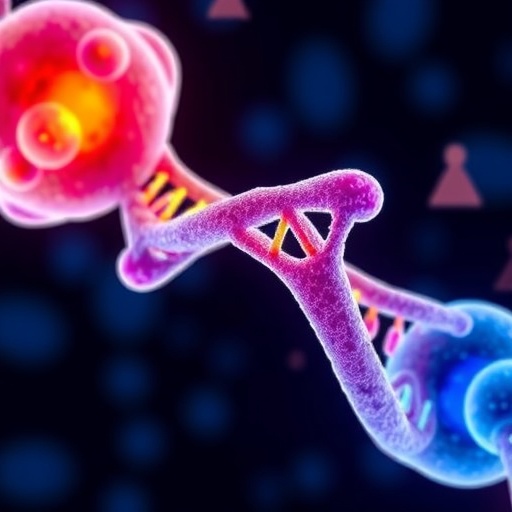Researchers at the University of North Carolina Lineberger Comprehensive Cancer Center have recently made significant strides in cancer treatment by developing an innovative “two-in-one” molecule designed to simultaneously silence two genes widely recognized for their roles in cancer progression: KRAS and MYC. These findings promise a radical approach to treating cancers notoriously resistant to traditional therapies, offering new hope for patients grappling with these difficult conditions.
.adsslot_kDornLmYGt{width:728px !important;height:90px !important;}
@media(max-width:1199px){ .adsslot_kDornLmYGt{width:468px !important;height:60px !important;}
}
@media(max-width:767px){ .adsslot_kDornLmYGt{width:320px !important;height:50px !important;}
}
ADVERTISEMENT
Chad V. Pecot, MD, a leading author of the study and a professor at the UNC School of Medicine, highlighted the revolutionary potential of this dual-targeting strategy, likening it to striking at both Achilles’ heels of cancer. His insights shed light on the transformative implications of effectively co-targeting KRAS and MYC, arguing that this innovative molecular strategy opens avenues for developing treatments that could impact multiple cancer types by affecting any combination of genes of interest.
The paper detailing these findings was published in the Journal of Clinical Investigation, and the authors have carefully documented their results and methods. The clinical implications of this research extend far beyond simply silencing KRAS and MYC. Developing a molecule capable of targeting these two significant oncogenes simultaneously might herald a new era in the treatment of various cancers, particularly in instances where both genes are critical for maintaining the survival of cancer cells.
Traditional approaches to targeting MYC have been fraught with challenges, leading to the conclusion that although MYC is a vital target for cancer therapeutics, successful drugs specifically targeting this gene have yet to be developed. Pecot emphasized the clinical significance of this study as one of the early investigations deeply analyzing the therapeutic benefits of simultaneously targeting KRAS and MYC. Furthermore, he pointed out that the newly created “two-in-one” molecule permits the researchers to explore the feasibility of targeting a third gene concurrently, expanding the potential applications of this technology.
The broader concept that most cancers are sustained by a range of genetic mutations underlines the immense value of this dual-targeting technology. It provides a novel approach for simultaneously addressing two vital drivers of tumor growth, thereby enhancing therapeutic efficacy. The potential application of this strategy could lead to significant advancements in the treatment landscape, particularly for aggressive cancers that either are presently managed poorly or have limited treatment options available.
Continuing from their previous work, where Pecot and his team published a study that delineated a targeted drug delivery mechanism for a specific KRAS mutation, the new findings represent further evolution in their ongoing quest to combat KRAS-related malignancies. While the earlier research focused on KRAS G12V, a specific variant, the newly developed capacities enable silencing all KRAS mutations, making the technology potentially applicable to a broader range of patients.
The ability to silence all KRAS mutations could significantly affect the treatment of prevalent cancers. For instance, lung, colorectal, and pancreatic cancers, all of which prominently feature KRAS mutations, are expected to be responsible for nearly half a million new cancer cases in the United States this year alone, according to statistics from the American Cancer Society. This statistic accentuates the urgent need for effective therapeutic approaches targeting these malignancies.
With the advent of such RNA therapeutics stemming from ongoing research projects at UNC’s RNA Discovery Center, the potential for breakthroughs in cancer treatment becomes increasingly tangible. Pecot expressed optimism about these advancements, suggesting that they might pave the way for hope and significant changes for patients diagnosed with KRAS-related cancers.
In conclusion, the development of a dual-targeting RNA molecule represents a pivotal step towards overcoming the challenges associated with treating cancers fueled by KRAS and MYC. The success of this innovative strategy epitomizes the rapidly evolving field of RNA therapeutics and highlights the need for ongoing research in molecular strategies to address the complexities of cancer treatment.
Subject of Research: Cells
Article Title: Inverted chimeric RNAi molecules synergistically co-target MYC and KRAS in KRAS-driven cancers
News Publication Date: 31-Jul-2025
Web References: Journal of Clinical Investigation
References: Cancer Cell
Image Credits: Credit: UNC Lineberger Comprehensive Cancer Center
Keywords
Cancer, RNA interference, KRAS, MYC, lung cancer, colon cancer, pancreatic cancer.
Tags: aggressive tumor developmentcancer treatment breakthroughsdual-target molecular therapiesimproving patient outcomes in cancer therapyinnovative cancer therapiesnovel cancer treatment strategiesovercoming cancer drug resistanceRNA interference technology in oncologysilencing undruggable cancer genessmall interfering RNAs in cancertargeting KRAS and MYC genesUniversity of North Carolina cancer research





